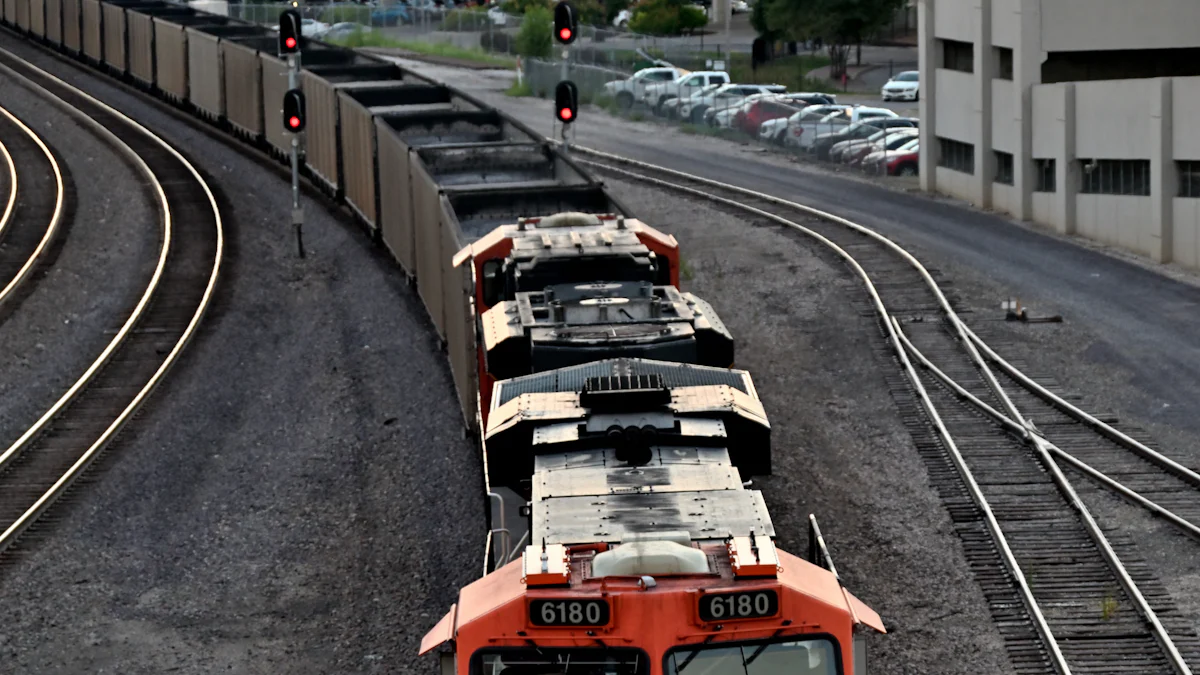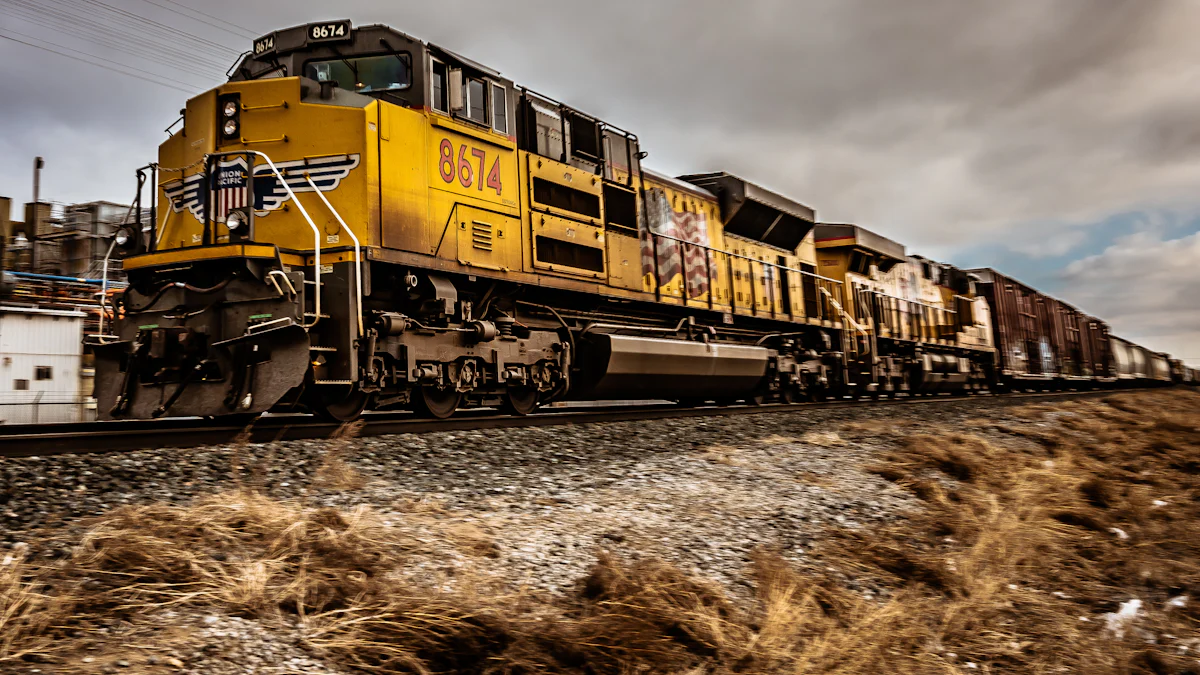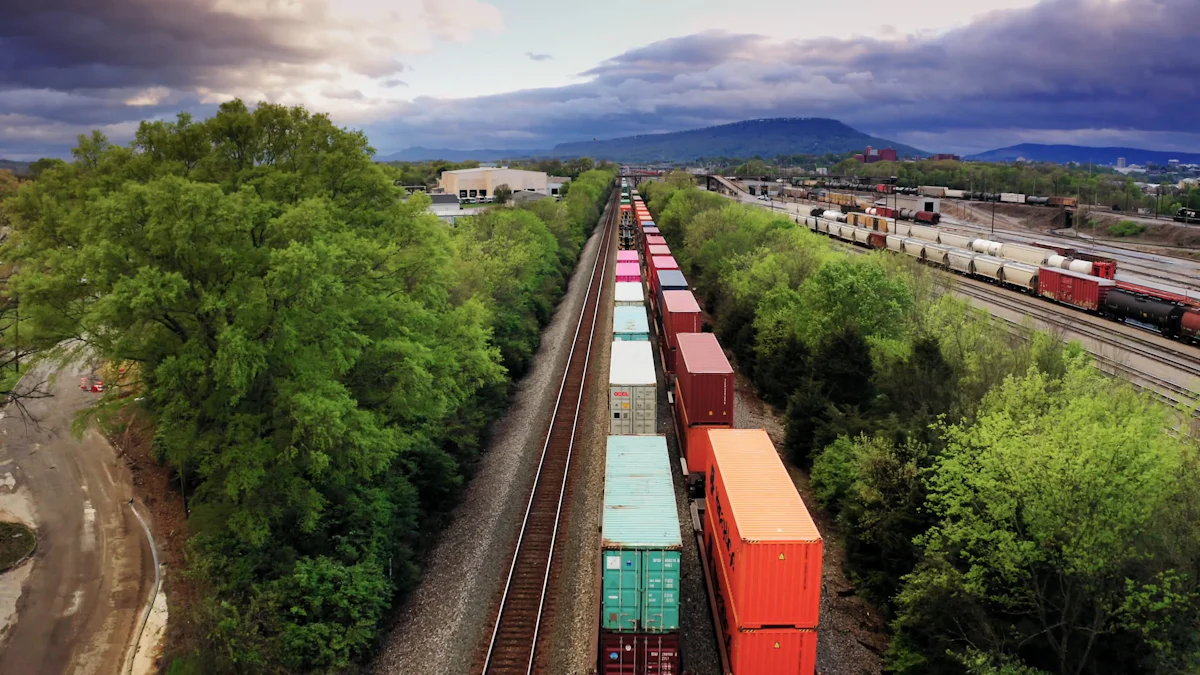2025 Rail Freight Industry: Key Trends to Watch

The Rail Freight industry plays a crucial role in global logistics and economic growth. In 2025, understanding the industry's evolving landscape becomes essential for stakeholders. Key trends will shape operational efficiencies, sustainability efforts, and market dynamics. These insights will help industry professionals navigate challenges and seize opportunities.
Technological Advancements in Rail Freight

Automation and AI in Rail Freight
Impact on Operational Efficiency
Rail Freight operations have seen significant improvements due to automation and AI. AI-powered systems optimize operations in real-time. RailVision Analytics has launched AI-enabled software that allows minor adjustments for train operation and fuel cost savings. These advancements enhance operational efficiency by reducing delays and improving scheduling accuracy. AI utilizes data to anticipate events, avoid risks, and create innovative solutions. This predictive intelligence leads to more efficient and reliable Rail Freight services.
Challenges and Opportunities
Automation and AI present both challenges and opportunities for the Rail Freight industry. Implementing these technologies requires substantial investment in infrastructure and training. Companies must address cybersecurity concerns to protect sensitive data. However, the benefits outweigh the challenges. AI enhances efficiency with personalized service offerings and predictive maintenance. The industry can reduce greenhouse gas emissions through AI-enabled software. These opportunities position Rail Freight as a leader in sustainable transportation.
IoT and Smart Railways
Real-time Tracking and Monitoring
The Internet of Things (IoT) revolutionizes Rail Freight by enabling real-time tracking and monitoring. Sensors installed on trains and tracks collect data continuously. This data provides insights into train locations, cargo conditions, and track health. Real-time tracking improves transparency and allows stakeholders to make informed decisions. Customers benefit from accurate delivery times and enhanced service reliability. IoT ensures Rail Freight operations remain efficient and responsive to changing conditions.
Predictive Maintenance
Predictive maintenance, powered by IoT, transforms Rail Freight maintenance practices. Sensors detect potential issues before they become critical problems. This proactive approach reduces downtime and extends the lifespan of rail assets. Maintenance teams can schedule repairs based on data-driven insights, minimizing disruptions. Predictive maintenance enhances safety and reliability in Rail Freight operations. The industry benefits from lower maintenance costs and improved asset utilization.
Environmental and Sustainability Initiatives in Rail Freight

Green Technologies
Electrification of Rail Networks
Electrification of rail networks stands as a pivotal advancement in Rail Freight. Electrified railways reduce reliance on fossil fuels. This transition cuts greenhouse gas emissions significantly. European countries lead the charge in electrification projects. The European Union funds extensive rail electrification initiatives. These efforts aim to achieve carbon neutrality by 2050. Electrification also enhances energy efficiency. Electric trains operate more smoothly and require less maintenance. The Rail Freight industry benefits from lower operational costs and improved reliability.
Use of Alternative Fuels
The use of alternative fuels represents another critical trend in Rail Freight sustainability. Biofuels and hydrogen fuel cells offer promising solutions. Biofuels derived from organic materials reduce carbon footprints. Hydrogen fuel cells produce zero emissions during operation. Companies like Alstom have pioneered hydrogen-powered trains. These trains operate successfully in Germany and other regions. The adoption of alternative fuels supports global sustainability goals. Rail Freight companies invest in research and development for cleaner fuel options. This investment drives innovation and positions the industry as an environmental leader.
Regulatory Changes
Emission Standards
Regulatory changes play a crucial role in shaping Rail Freight sustainability. Emission standards set by authorities like the EPA enforce strict limits. The EPA regulations ensure locomotives meet appropriate emissions criteria. Jessica Kahanek from the Association of American Railroads emphasizes the importance of these regulations. Compliance with emission standards reduces harmful pollutants. This compliance protects public health and the environment. Rail Freight operators must adapt to evolving regulatory landscapes. Adherence to stringent standards demonstrates a commitment to sustainability.
Compliance and Implementation
Compliance and implementation of new regulations present challenges and opportunities. The California Air Resources Board (CARB) proposes regulations to reduce locomotive emissions. CARB's proposal includes limiting idling and reducing stationary emissions. Exemptions exist for zero-emission capable locomotives. Rail Freight companies must invest in technology and infrastructure to comply. This investment includes upgrading existing fleets and adopting new technologies. Successful compliance enhances the industry's reputation. It also aligns Rail Freight operations with global environmental objectives.
Market Dynamics and Economic Factors in Rail Freight
Global Trade Patterns
Impact of Trade Agreements
Rail Freight plays a pivotal role in global trade. Trade agreements significantly impact Rail Freight operations. The United States-Mexico-Canada Agreement (USMCA) has streamlined cross-border rail transport. This agreement reduces tariffs and simplifies customs procedures. These changes enhance the efficiency of Rail Freight services between these countries. The European Union's trade agreements also influence Rail Freight. Agreements with countries like Japan and Canada facilitate smoother rail logistics. These agreements create new opportunities for Rail Freight companies.
Shifts in Major Trade Routes
Shifts in major trade routes affect Rail Freight dynamics. The Belt and Road Initiative (BRI) by China has altered traditional trade routes. This initiative connects Asia, Europe, and Africa through extensive rail networks. Rail Freight benefits from reduced transit times and costs. The Northern Sea Route, influenced by climate change, opens new possibilities. This route shortens the distance between Asia and Europe. Rail Freight companies must adapt to these shifts. Adapting ensures competitiveness in the evolving market.
Economic Growth and Investment
Infrastructure Development
Economic growth drives infrastructure development in Rail Freight. Countries invest heavily in rail infrastructure to support economic activities. Austria aims for a 40% share of all rail transport by 2040. Substantial investments in rail infrastructure support this goal. The United States has seen significant private investments in Rail Freight. From 1980 to 2022, U.S. freight railroads invested billions in infrastructure and equipment. These investments improve rail network efficiency and capacity. Enhanced infrastructure supports economic growth and Rail Freight operations.
Funding and Financing Trends
Funding and financing trends shape the future of Rail Freight. Public and private sectors collaborate to fund rail projects. Public-Private Partnerships (PPPs) play a crucial role. PPPs combine public funding with private expertise. This collaboration accelerates rail infrastructure projects. Governments provide grants and subsidies to support Rail Freight. These financial incentives encourage investments in sustainable technologies. Private investors also contribute through venture capital and equity investments. These funding trends ensure continuous growth and innovation in Rail Freight.
Industry Collaboration and Partnerships in Rail Freight
Public-Private Partnerships
Case Studies and Examples
Public-Private Partnerships (PPPs) have become pivotal in advancing the Rail Freight industry. One notable example is the Integrated Freight Complex in California. This project focuses on efficient intermodal transportation and private investments. The initiative has created 20,000 jobs and alleviated congestion around the Ports of Los Angeles and Long Beach. Another significant case is the China-Kyrgyzstan-Uzbekistan International Multimodal Freight Train Services. This partnership enhances connectivity between Central Asia and major economic hubs in China. The project offers more efficient and effective transportation compared to road transport.
Benefits and Challenges
PPPs offer numerous benefits to the Rail Freight sector. These partnerships provide access to additional funding sources, accelerating infrastructure development. Private investments bring innovative solutions and advanced technologies to the table. Public entities benefit from the expertise and efficiency of private partners. However, challenges also exist. Coordinating between public and private stakeholders can be complex. Regulatory hurdles and differing objectives may impede progress. Despite these challenges, the advantages of PPPs often outweigh the difficulties.
Cross-industry Collaborations
Integration with Other Transport Modes
Integration with other transport modes enhances the efficiency of Rail Freight operations. Combining rail with road, sea, and air transport creates a seamless logistics network. Intermodal transportation reduces transit times and costs. Efficient cargo transfer between different modes minimizes delays. For instance, the Integrated Freight Complex in California exemplifies successful intermodal integration. This project demonstrates how combining rail with other transport modes can alleviate congestion and improve overall logistics efficiency.
Innovations in Supply Chain Management
Innovations in supply chain management play a crucial role in the Rail Freight industry. Advanced technologies such as blockchain and IoT streamline operations. Blockchain ensures transparency and security in freight transactions. IoT enables real-time tracking and monitoring of cargo. These innovations enhance the reliability and efficiency of Rail Freight services. Companies can optimize routes, reduce delays, and improve customer satisfaction. The integration of advanced technologies positions the Rail Freight industry at the forefront of modern logistics.
The 2025 Rail Freight Industry will witness transformative trends. Technological advancements such as AI and IoT will enhance operational efficiency and predictive maintenance. Environmental initiatives like electrification and alternative fuels will drive sustainability. Market dynamics, including shifts in trade routes and infrastructure investments, will shape economic growth. Industry collaboration through public-private partnerships and cross-industry integrations will foster innovation.
Staying informed about these changes remains crucial for stakeholders. Adapting and innovating will ensure competitiveness and sustainability. The Rail Freight industry must embrace these trends to thrive in the evolving landscape.
See Also
5 Key Trends Shaping Future Supply Chain Efficiency
2024 Revealed: Latest Developments in Sea Freight Logistics
In-Depth Analysis: The Future Landscape of LTL Freight
Exploring Cutting-Edge Transport Technology for Supply Chains
